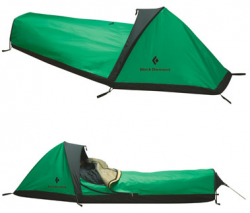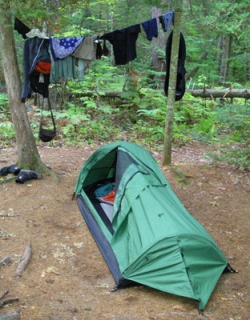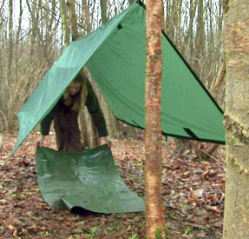What is a bivouac shelter?
Sleeping in a bivouac shelter often means sleeping in the open with a bivvy sack. But it also refers to a improvised shelter built entirely or partly from natural materials.
Both pictures above can be called a bivouac shelter but we're going to build the one shown in the bottom picture.
What you need:
- Bivouac or tarp
- Ground sheet
- Saw
- Knife
- Rope
Preparation
Make sure you choose the right spot to make camp. If you're stuck outside with little light and it's too dangerous to carry on then you would have to work with the environment you find yourself in.
But if you have a choice, there are a number of things to consider:
But if you have a choice, there are a number of things to consider:
- Where are you? - If you are in a higher exposed ground then head to a lower and more protected area.
- If you are in a valley then head to higher ground
- Hot air rises so the lower ground will tend to be colder and damp - Are there any natural resources? - Ideally you would want to be near a water source and a good source of fuel for your fire
- Are there animal trails nearby? - You don't any wild animals wandering around your camp at night
- Spend a minute checking the area above where you intend to camp. - Check for bees nest or dead branches which can fall down on you if the wind picks up.
- Always try to camp at the edge of a forest rather than at the middle of it so that you can see what's going on around you.
Location
- To make a good camp you will need find a flat piece of ground.
- You will also need two trees about 9 feet apart.
- Make sure the ground between the trees is free from any growth or foliage
Make the Pegs
- You need to make some pegs from wood.
- Find a long branch about as thick as your finger and cut short pegs from it.
- Sharpen the pegs at one end so that it would be easier for it to penetrate into the ground.
- Cut a notch into the other the other end where the rope will be secured to.
- Carefully trim the unsharpened end of the peg so that it does not split when it is driven into the ground.
Construction
There are a number of ways for constructing your camp but if your tarp is big enough, this is the best and warmest:
- Lay out your bivouac and pull out all the corners in between the two trees to make sure it will fit.
- Tie one end of the bivouac to the tree at about knee level - keeping the roof low will protect you from the rain better.
- Once one end is secured do the same for the other end.
- Make sure the line between the two trees is tight.
- Pull down the guy rope of the bivouac to make a roof - make sure it's tight.
- Hammer the pegs into the ground.
- Secure the guy rope to the peg.
- Do this for each corner of the bivouac.
- Tidy up the loose end of the guy rope.
- Lay down your groundsheet underneath the roof you just made.
Top 3 Bivvy Selection

Outdoor Research Advanced Bivy
The spacious Advanced Bivy™ can be used in place of a single tent. It is larger than the Alpine Bivy™, with more space for thicker sleeping pads and loftier bags. The patented dual-pole system can be used for increased ventilation and interior space, or left behind when weight and pack space are critical. The GORE-TEX® Respiration Positive™ fabric allows warm moist air to escape to avoid condensation while providing supreme weather protection. A zippered vent at the base improves airflow on humid nights.
Avg. Weight (oz./g): 39.0 / 1106
The spacious Advanced Bivy™ can be used in place of a single tent. It is larger than the Alpine Bivy™, with more space for thicker sleeping pads and loftier bags. The patented dual-pole system can be used for increased ventilation and interior space, or left behind when weight and pack space are critical. The GORE-TEX® Respiration Positive™ fabric allows warm moist air to escape to avoid condensation while providing supreme weather protection. A zippered vent at the base improves airflow on humid nights.
Avg. Weight (oz./g): 39.0 / 1106

Outdoor Research Alpine Bivy
The Alpine Bivy™ has everything necessary for long nights above tree line. The GORE-TEX® Respiration Positive™ fabric offers complete protection from rain and snow storms without collecting interior condensation. The overlapped zipper opening allows you to breathe freely without letting weather in. A single pole can be used to create overhead space, or it can be left at the trailhead.
Avg. Weight (oz./g): 32.0 / 907
The Alpine Bivy™ has everything necessary for long nights above tree line. The GORE-TEX® Respiration Positive™ fabric offers complete protection from rain and snow storms without collecting interior condensation. The overlapped zipper opening allows you to breathe freely without letting weather in. A single pole can be used to create overhead space, or it can be left at the trailhead.
Avg. Weight (oz./g): 32.0 / 907

Black Diamond Tripod Bivy
For comfortable bivying in harsh alpine environments, the freestanding Tripod Bivy bridges the gap between a bivy sack and a one-person tent. The three Easton aluminum poles lift the bivouac sack away from your head and feet. It’s built from waterproof, windproof and breathable ToddTex with a polyurethane-laminated bathtub floor, and all seams are sewn with heavy duty nylon and factory taped. The Tripod has a large zippered entry with a sizable no-see-um mesh panel to keep the critters out and allow the fresh air in. Stuff sack included.
For comfortable bivying in harsh alpine environments, the freestanding Tripod Bivy bridges the gap between a bivy sack and a one-person tent. The three Easton aluminum poles lift the bivouac sack away from your head and feet. It’s built from waterproof, windproof and breathable ToddTex with a polyurethane-laminated bathtub floor, and all seams are sewn with heavy duty nylon and factory taped. The Tripod has a large zippered entry with a sizable no-see-um mesh panel to keep the critters out and allow the fresh air in. Stuff sack included.


